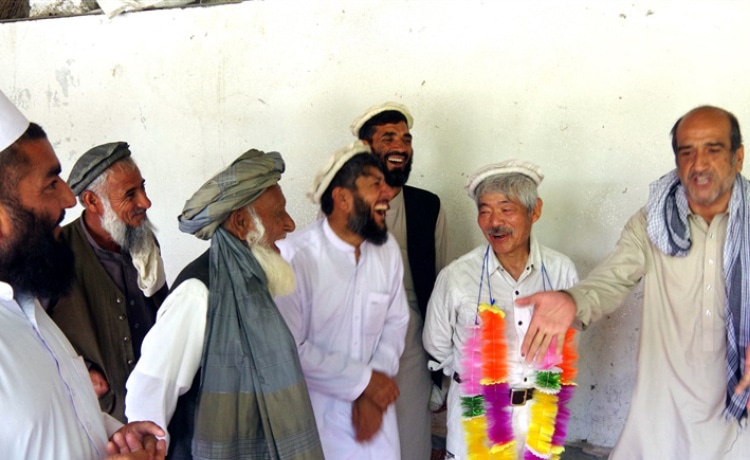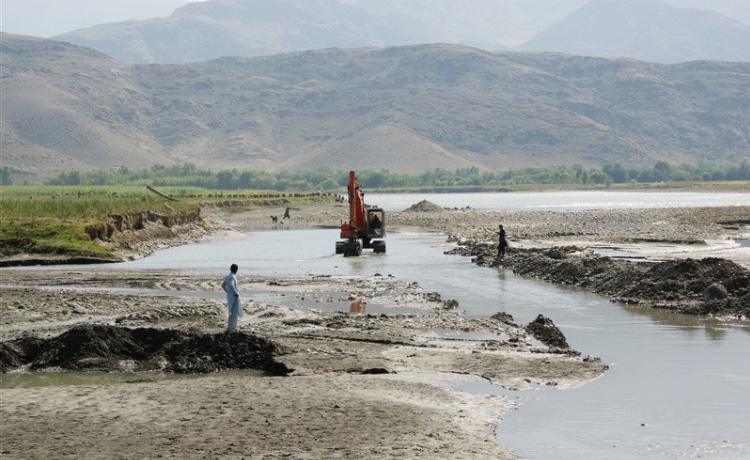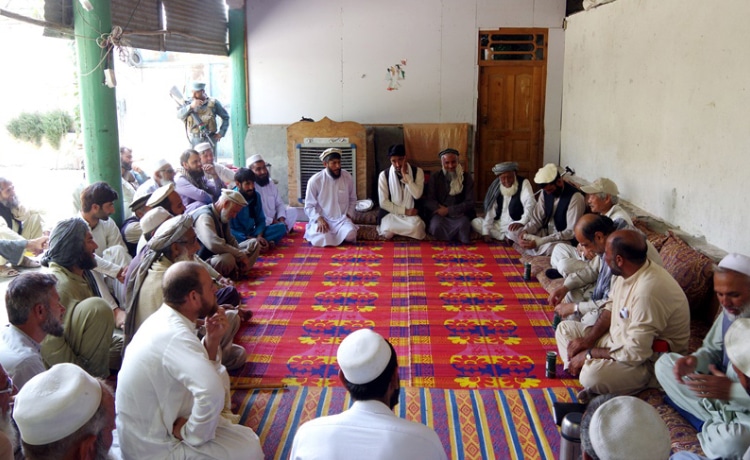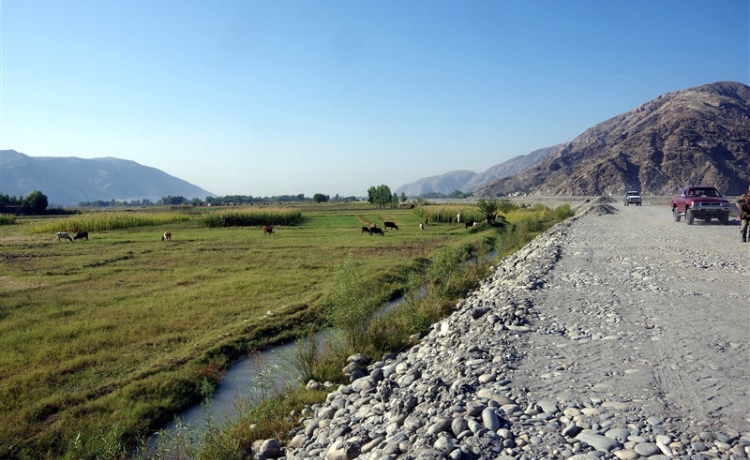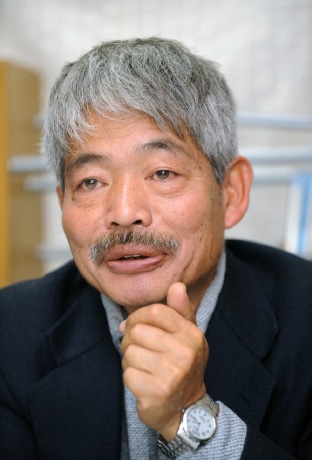【In the Land of the Afghans – Reports from Dr. Tetsu Nakamura】Faith and values in the mountains
Published on December 2, 2019 – The Nishinippon Newspaper
In 2020, our Green Ground Project providing irrigation water to farming villages north of Jalalabad, the provincial center of eastern Afghanistan, is entering its final phase. We have operated primarily in the Kunar River basin, which originates high up in the Hindu Kush range. The villages are scattered across valleys, some are in remote and isolated areas.
Whereas settlements in the semi-plains have relatively large populations and significant public investment in development, life in the small villages is typically left alone to continue as it has for millennia. These villages tend to adhere strictly to their traditional cultural practices. As a result, foreigners rarely, if ever, come to visit. Prior to this phase, our irrigation project also did not prioritize isolated villages, instead focusing its limited resources on areas where the “economic impact” would be greater.
■A legend draws on tribal affiliations
With a population of about 5,000 and less than 200 hectares of arable land, Goryak is one such village. While the Japan International Volunteer Center (JVC), a non-governmental organization (NGO), has run primary healthcare clinics here, no previous large-scale development initiatives have been carried out in the area. In this phase of the project, the Peace Japan Medical Services (PMS) has targeted its support at these villages which had until now been neglected, in order to ensure that the irrigation scheme benefits the entire Kunar River basin.
Goryak is a half-day drive from Jalalabad, which requires crossing Kunar River from Dara-e-Nur on rafts or taking an alternative route by boat going upstream from a village where PMS has been operating a project for three years. Limited interaction with surrounding villages has allowed Goryak to develop and maintain a distinctive character. It is the only Pashayi village in a region that is predominantly ethnic Pashtun, and life in the village is patriarchal and feudal in nature.
The Pashayi are a mountain-dwelling tribe who, like the Nuristan ethnic group, reside in eastern Afghanistan. The leader of Goryak Village is a legendary local headman and the villagers are united by their allegiance to him. His name is so well-known in the area that it is sufficient to ward off potential threats to the village.
In mid-October, we visited the village for the first time to carry out a preliminary assessment for the irrigation scheme. Although a weir had been constructed by PMS on the opposite bank of Kunar River, water intake has become difficult due to the shifting of the river route. Without additional construction from the Goryak side of the river, the overall efficacy of the scheme would be impaired. On the Goryak side, their farmlands have turned barren because of repeated flash floods, with their existing intake system not working properly. We, therefore, planned to proceed with construction and repairs on both sides of the river to resolve the existing problems.
We were escorted upon arrival to a guest house where some 200 heads of household had gathered to welcome our party. The village was similar to any other mountain hamlet, well-maintained in spite of its innate poverty. As visitors, we didn’t come away with any sense of misery related to their economic situation.
The village leader, 80 years old, attended to us as their representative. His reputation led us to expect a formidable presence, but we were greeted instead by a well-mannered gentleman of modest stature. Dignified but not overbearing, his wishes were communicated through simple glances and carried out straight away.
The work of PMS was already well-known to the villagers because nearby sections of the irrigation project were nearing completion.
"Do you have any problems with water supply or harvests in your village?" we inquired of the village leader.
"We will leave this work to qualified experts such as yourselves. We believe in the sincerity of your efforts. We are pleased to be able to welcome you to our village."
■A dying way of life
It is truly a rarity to hear such words in today’s world. In spite of their harsh lifestyle, these villagers live with nothing more than their belief in God and humanity. Their morals and mindset were once widespread but are now everywhere in decline, nowhere more conspicuously than in major urban centers where people have shifted away from communal values. The consequences of the international military intervention 18 years ago, in 2001, and the subsequent modernization of the country are increasingly coming into focus. Even among Afghans, the backwardness of rural life draws much criticism, and traditional views on matters of loyalty and faith are considered more and more outdated.
Modernization and democracy are often synonymous. In the megacity of Kabul, fashions like those worn in Tokyo or London are popular among the upper classes. Previously unknown levels of traffic congestion produce exhaust fumes that smother the city streets in a haze. Notwithstanding the clamor for human rights, fewer and fewer people show kindness to the destitute and the displaced. And you would be hard-pressed to call the contaminated Kabul River, a river any longer, as mountains of plastic waste accumulate on its banks.
A dearth of responsibility for the environment; a longing for a bright, consumerist lifestyle resembling that in other countries; a never-ending civil conflict; drought due to global warming. From this apocalyptic reality, what is Afghanistan trying to reveal to us? Looking beyond the appeal of modernization, we continue to question why heart-warming human bonds can exist in an abandoned periphery of the world.
× ×
This is a translation of a report from Afghanistan by Dr. Tetsu Nakamura, a Japanese medical doctor who was gunned down on December 4, 2019 in Afghanistan at the age of 73. Dr. Nakamura was the head of the international NGO, Peace Japan Medical Services (PMS). In addition to medical services, PMS provides various forms of assistance to local communities in Afghanistan’s eastern Nangarhar province, including the construction of irrigation systems, related agricultural programming and provision of food support. PMS is funded by Peshawar-kai, which was established in 1983 to collect donations from people and support the project implementation of Dr. Nakamura and his team.
This report is one of 27 installments in the series “In the Land of the Afghans – Reports from Dr. Tetsu Nakamura,” which ran from May 25, 2009 to December 2, 2019. They were originally published by the local newspaper in Dr. Nakamura’s hometown in Fukuoka, Japan. The text has been translated from Japanese to English, with the support of Peshawar-kai, by more than 30 volunteers, many of whom work in the field of humanitarian and development aid, and who have been and will continue to be inspired by Dr. Nakamura's work and philosophy.


